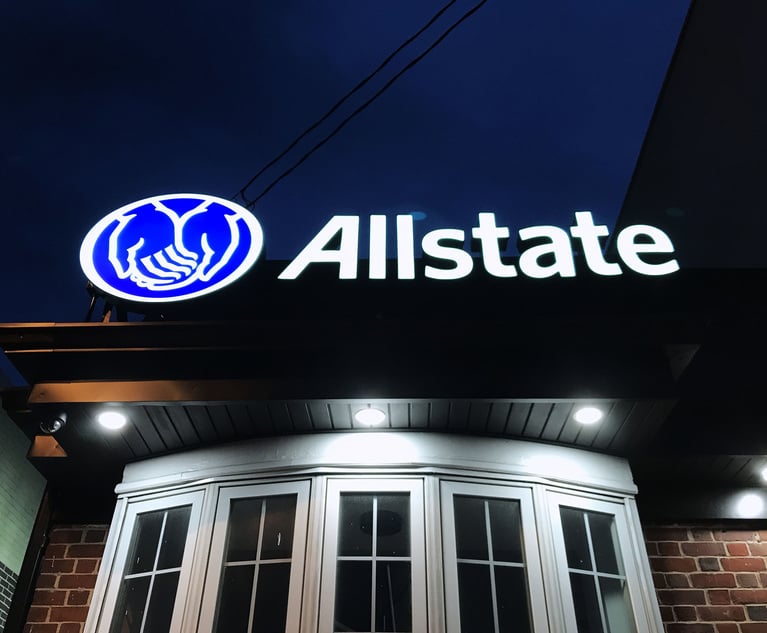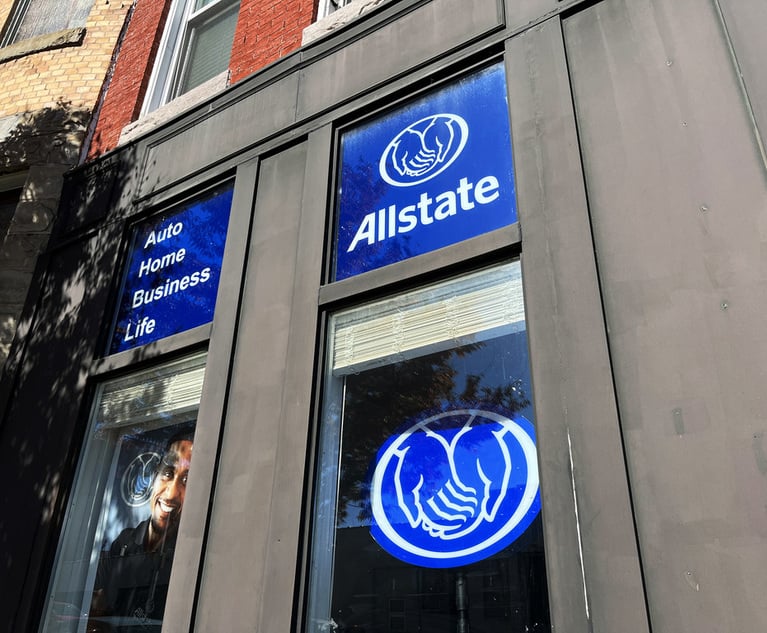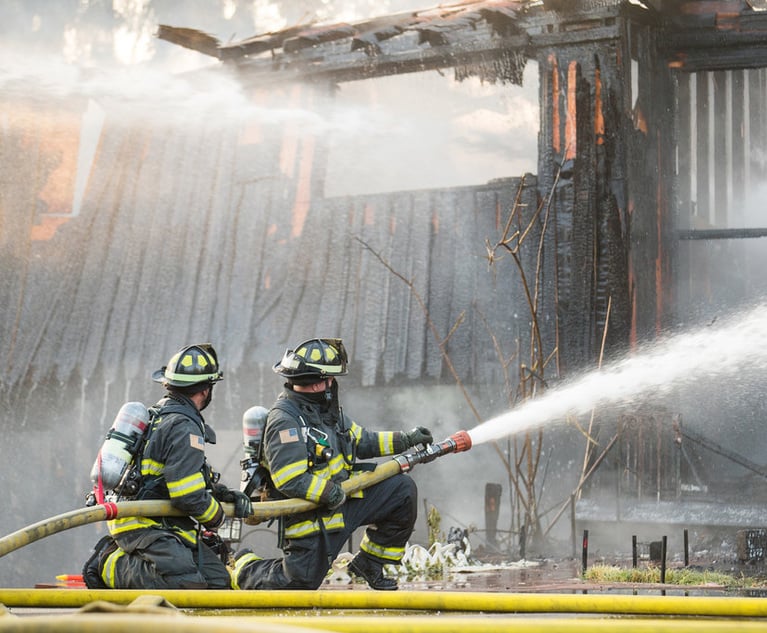Eight-Corners Rule and Extrinsic Evidence: Never … Sometimes … Maybe?
Most appellate courts and commentators consider the "eight-corners rule" a settled feature of Texas law. But is it really that settled?
April 20, 2020 at 07:40 PM
6 minute read
 Ryan Logan Valdez of Cantey Hanger.
Ryan Logan Valdez of Cantey Hanger.
The eight-corners rule is an obvious, self-explanatory rule. It says what it means, and it means what it says, right?
Maybe. It's complicated.
Under the eight-corners rule, an insurer's duty to defend its insured is determined by comparing the claims asserted in the "four corners" of the petition with the language in the "four corners" of the insured's insurance policy. If these "eight corners" overlap—even slightly—then the insurer must defend its insured without regard to the truth or falsity of the allegations in the petition.
The Texas Supreme Court first applied the eight-corners rule in 1965 in Heyden Newport Chemical v. Southern General Insurance and has repeatedly affirmed it, generally prohibiting courts from considering evidence outside of the "eight corners"—even if extrinsic evidence contradicts the allegations of the underlying petition. As a result, most appellate courts and commentators consider the "eight-corners rule" a settled feature of Texas law.
But is it really that settled?
In the 2004 case Northfield Insurance v. Loving Home Care, the U.S. Court of Appeals for the Fifth Circuit, applying Texas law, adopted an exception to the "eight-corners rule" and allowed extrinsic evidence to bear on the duty to defend. Under the Northfield exception, courts may consider extrinsic evidence when (1) "it is initially impossible to discern whether coverage is potentially implicated" and (2) "the extrinsic evidence goes solely to a fundamental issue of coverage which does not overlap with the merits or engage the truth or falsity of any facts alleged in the underlying case."
At least three Texas appellate courts (Houston (14th District), Texarkana and Waco) have adopted some version of the Northfield exception, while at least three other appellate courts (Amarillo, Dallas and Houston (First District)) have declined to follow it. The Texas Supreme Court has twice acknowledged the Northfield exception, but has never affirmed or rejected it.
With a split in authority and no definitive guidance from the Texas Supreme Court, where does the eight-corners rule's prohibition on extrinsic evidence stand today? Is extrinsic evidence admissible, or are parties stuck with only the "eight corners" of the petition and the policy?
In March of this year, the Texas Supreme Court accepted a certified question from the Fifth Circuit to address another potential exception to the eight-corners rule. In Richards v. State Farm Lloyds, a child died in an all-terrain vehicle accident while under the supervision of his grandparents. The child's mother sued the grandparents for negligent supervision and alleged that the accident occurred on or near the grandparents' residence.
The grandparents requested that their homeowner's insurer, State Farm, defend them from the lawsuit. State Farm agreed to provide a defense under a reservation of rights and then filed suit in the U.S. District Court for the Northern District of Texas, seeking a declaration that it had no duty to defend under two exclusions to the policy.
First, the policy excluded coverage for "bodily injury" arising from the use of an ATV "while off an insured location." State Farm argued that the accident arose from the grandparents' use of the ATV "off an insured location"—a public recreational trail. As proof, State Farm submitted the police report, which had not been included in the underlying petition.
Second, the policy excluded coverage for "bodily injury" to "any other person under the age of 21 who is in the care of" the named insureds. As proof that the deceased was a minor "in the care of" his grandparents, State Farm submitted a court order from a suit affecting the parent-child relationship, which was also had not been included in the underlying petition.
State Farm moved for summary judgment on the basis of the two exclusions. In response, the grandparents argued that the eight-corners rule prohibited the district court from considering any extrinsic evidence, including the crash report and the order.
In considering the proffered evidence, U.S. District Judge John H. McBryde of the Northern District of Texas cited his prior decision in B. Hall Contracting v. Evanston Insurance and determined that the eight-corners rule only applied to insurance policies that explicitly required the insurer to defend "all actions against its insured no matter if the allegations are groundless, false or fraudulent." Because the policy at issue did not contain such a "groundless-claims clause," the district court granted summary judgment for State Farm, considered the proffered evidence, and found that the eight-corners rule did not apply. The grandparents appealed, and the Fifth Circuit certified the following question to the Texas Supreme Court:
Is the policy-language exception to the eight-corners rule articulated in B. Hall Contracting a permissible exception under Texas law?
The Texas Supreme Court framed the question as not whether parties can contract around the eight-corners rule (they can), but whether the Richards parties actually did so given the absence of a "groundless-claims clause" in the policy. Noting that a large insurance company like State Farm "knows how to contract around" the duty to defend, the court held that State Farm "did not do so merely by omitting the words 'groundless, false or fraudulent,' or similar words, from this policy." In so holding, the Texas Supreme Court rejected the district court's application "groundless-claim clause" exception.
The Texas Supreme Court refused to resolve any matters or foreclose any arguments beyond the violability of the "groundless-claims clause" exception. The court expressly reserved to comment on "whether other policy language or other factual scenarios may justify the use of extrinsic evidence" in determining the duty to defend.
Given the limited effect of the court's holding, Richards does little to shed light on the bigger issue—can courts consider ever extrinsic evidence in determining the duty to defend and, if so, when?
Maybe. It's complicated.
Ryan Logan Valdez is a trial and appellate lawyer representing Fortune 500 companies, locally owned and regional businesses, and individuals in complex commercial disputes. Valdez's practice focuses on matters involving insurance coverage and bad faith, fraud, breach of contract, restrictive covenant enforcement, homeowners associations, employment practices and discrimination, products liability, and negligence.
This content has been archived. It is available through our partners, LexisNexis® and Bloomberg Law.
To view this content, please continue to their sites.
Not a Lexis Subscriber?
Subscribe Now
Not a Bloomberg Law Subscriber?
Subscribe Now
NOT FOR REPRINT
© 2025 ALM Global, LLC, All Rights Reserved. Request academic re-use from www.copyright.com. All other uses, submit a request to [email protected]. For more information visit Asset & Logo Licensing.
You Might Like
View All

Allstate Is Using Cell Phone Data to Raise Prices, Attorney General Claims
5 minute read
Once the LA Fires Are Extinguished, Expect the Litigation to Unfold for Years
5 minute read
Texas Insurer Slaps Hinshaw & Culbertson With Legal Mal Claim Over $11 Million Personal Injury Jury Award
3 minute readLaw Firms Mentioned
Trending Stories
- 1Top 10 Predictions for the Legal Technology Job Market in 2025
- 2FTC's Info Security Action Against GoDaddy Sends 'Clear Signal' to Web Hosting Industry: Expert
- 3Data Disposition—Conquering the Seemingly Unscalable Mountain
- 4Who Are the Judges Assigned to Challenges to Trump’s Birthright Citizenship Order?
- 5Litigators of the Week: A Directed Verdict Win for Cisco in a West Texas Patent Case
Who Got The Work
J. Brugh Lower of Gibbons has entered an appearance for industrial equipment supplier Devco Corporation in a pending trademark infringement lawsuit. The suit, accusing the defendant of selling knock-off Graco products, was filed Dec. 18 in New Jersey District Court by Rivkin Radler on behalf of Graco Inc. and Graco Minnesota. The case, assigned to U.S. District Judge Zahid N. Quraishi, is 3:24-cv-11294, Graco Inc. et al v. Devco Corporation.
Who Got The Work
Rebecca Maller-Stein and Kent A. Yalowitz of Arnold & Porter Kaye Scholer have entered their appearances for Hanaco Venture Capital and its executives, Lior Prosor and David Frankel, in a pending securities lawsuit. The action, filed on Dec. 24 in New York Southern District Court by Zell, Aron & Co. on behalf of Goldeneye Advisors, accuses the defendants of negligently and fraudulently managing the plaintiff's $1 million investment. The case, assigned to U.S. District Judge Vernon S. Broderick, is 1:24-cv-09918, Goldeneye Advisors, LLC v. Hanaco Venture Capital, Ltd. et al.
Who Got The Work
Attorneys from A&O Shearman has stepped in as defense counsel for Toronto-Dominion Bank and other defendants in a pending securities class action. The suit, filed Dec. 11 in New York Southern District Court by Bleichmar Fonti & Auld, accuses the defendants of concealing the bank's 'pervasive' deficiencies in regards to its compliance with the Bank Secrecy Act and the quality of its anti-money laundering controls. The case, assigned to U.S. District Judge Arun Subramanian, is 1:24-cv-09445, Gonzalez v. The Toronto-Dominion Bank et al.
Who Got The Work
Crown Castle International, a Pennsylvania company providing shared communications infrastructure, has turned to Luke D. Wolf of Gordon Rees Scully Mansukhani to fend off a pending breach-of-contract lawsuit. The court action, filed Nov. 25 in Michigan Eastern District Court by Hooper Hathaway PC on behalf of The Town Residences LLC, accuses Crown Castle of failing to transfer approximately $30,000 in utility payments from T-Mobile in breach of a roof-top lease and assignment agreement. The case, assigned to U.S. District Judge Susan K. Declercq, is 2:24-cv-13131, The Town Residences LLC v. T-Mobile US, Inc. et al.
Who Got The Work
Wilfred P. Coronato and Daniel M. Schwartz of McCarter & English have stepped in as defense counsel to Electrolux Home Products Inc. in a pending product liability lawsuit. The court action, filed Nov. 26 in New York Eastern District Court by Poulos Lopiccolo PC and Nagel Rice LLP on behalf of David Stern, alleges that the defendant's refrigerators’ drawers and shelving repeatedly break and fall apart within months after purchase. The case, assigned to U.S. District Judge Joan M. Azrack, is 2:24-cv-08204, Stern v. Electrolux Home Products, Inc.
Featured Firms
Law Offices of Gary Martin Hays & Associates, P.C.
(470) 294-1674
Law Offices of Mark E. Salomone
(857) 444-6468
Smith & Hassler
(713) 739-1250






